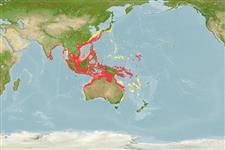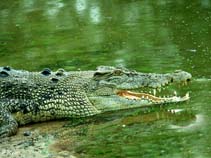Crocodylus porosus Schneider, 1801
Estuarine crocodile| Native range | All suitable habitat | Point map | Year 2050 |

|
| This map was computer-generated and has not yet been reviewed. |
| Crocodylus porosus AquaMaps Data sources: GBIF OBIS |
Classification / Names Common names | Synonyms | CoL | ITIS | WoRMS
Reptilia | Crocodilia | Crocodylidae
Environment: milieu / climate zone / depth range / distribution range Ecology
Pelagic; oceanodromous (Ref. 77091); freshwater; depth range 0 - 200 m. Tropical; 41°N - 36°S, 77°E - 171°E (Ref. 356)
Distribution Countries | FAO areas | Ecosystems | Occurrences | Introductions
Indo-West Pacific.
Length at first maturity / Size / Weight / Age
Maturity: Lm 110.0 range ? - ? cm Max length : 615 cm TL male/unsexed; (Ref. 77094)
Short description Morphology
Large head and strong snout with a pair of ridges bridging the orbits. Uniform dorsal scales. Very variable coloration. Juveniles with black bands and spots. Body with 4-5 black bands which may disappear in very large individuals. The belly is uniformly colored beige to golden yellow. Some individuals maybe highly pigmented.
May cross open ocean as evidenced by occurrence in remote islands in the Indian Ocean and in the western Pacific Ocean (salinity range 5-20 per mille). Inhabits a wide range of habitats (rivers, creeks, swamps, lagoons and billabongs); needs a source of water less salty than their blood (blood plasma salinity of 11per mille). Ref. 77096 reports a maximum length of 700 cm total length and a maximum weight of 1000 kg for captive individuals. Often basks on open mud banks in cooler months and often in the shade of mangrove areas in warmer months. Has a strong homing ability. Oceanodromous individuals may have barnacles attached to their scales (Ref. 77096). May also have endoparasites, i.e., round worms, tongue worms and flukes (Ref. 77091). Crocodile eggs and flesh are food for humans, while crocodile skin (notably near the belly) are used by the leather industry mostly from farmed crocodiles (Ref. 77091). Known to attack humans, sometimes fatally (Ref. 077096, 077099). Active throughout the year. Hunts by day and night; hunting probably associated to diving behavior. Size determines feeding, i.e., small crocodiles feed frequently on small prey items while larger crocodiles feed infrequently on larger prey. May consume carrion. Gastroliths (stomach stones) help in digesting food items (Ref. 77091).
Life cycle and mating behavior Maturity | Reproduction | Spawning | Eggs | Fecundity | Larvae
Main reference
References | Coordinator | Collaborators
Greer, A.E. 2006. (Ref. 77091)
IUCN Red List Status (Ref. 130435)
Least Concern (LC) ; Date assessed: 14 November 2019
CITES status (Ref. 108899)
Appendix I: International trade banned
CMS (Ref. 116361)
Appendix II: Migratory species conserved through agreements
Threat to humans
Traumatogenic (Ref. 77096)
Human uses
Fisheries: commercial; aquaculture: commercial
FAO - Fisheries: landings | FishSource | Sea Around Us
Tools
More information
Internet sources
BHL | BOLD Systems | CISTI | DiscoverLife | FAO(Fisheries: ; publication : search) | Fishipedia | GenBank (genome, nucleotide) | GloBI | Gomexsi | Google Books | Google Scholar | Google | PubMed | Tree of Life | Wikipedia (Go, Search) | Zoological Record
Estimates based on models
Preferred temperature
(Ref. 115969): 24.2 - 29.1, mean 28.1 (based on 3318 cells).
Resilience
(Ref. 69278):
High, minimum population doubling time less than 15 months (K=0.71-2.5).
Price category
(Ref. 80766):
Unknown.



